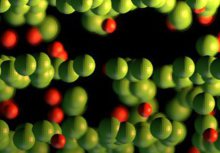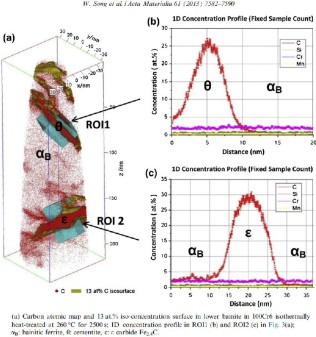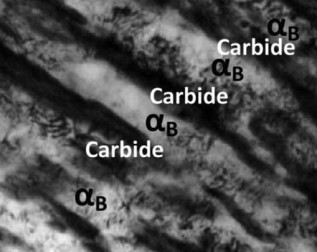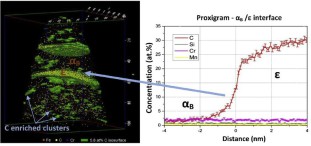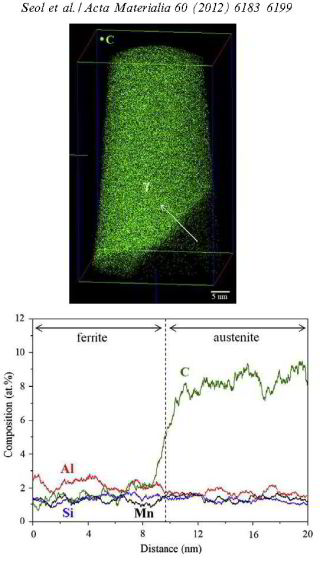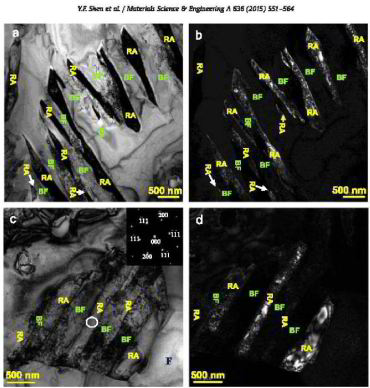Bainite
What is Bainite ?
Bainite is a crystalline microstructure feature that forms in steel upon heating and guided cooling. It is named after Edgar C. Bain, a US metallurgist who worked on the alloying and heat treatment of steel in Pittsburgh in Pennsylvania. Bainite is not a phase in thermodynamic sense but an acicular microstructure that can form in certain steels at temperatures of 250–550 °C, depending on the alloy composition, specifically on the carbon content. It can be formed as a decomposition product form cooling austenite below a critical temperature that depends on the alloy content. Bainite commonly consists of cementite and dislocation-rich ferrite. The high concentration of dislocations in the ferrite present in bainite makes this ferrite hard.
The cementite in Bainite is typically not regularly arranged in the form of parallel arrays or plates but appears instead in the form of many irregularly arranged precipitates inside small dislocation-rich ferrite grains.
What are the properties of bainitic steels?
Advantages of bainitic steels include:
- High Strength: Bainitic steels exhibit exceptionally high strength, making them ideal for applications that require excellent load-bearing capacity. Their strength is comparable to or even superior to some of the conventional high-strength steels, such as martensitic steels. This property enables the use of bainitic steels in demanding structural applications where strength is a critical requirement.
- Toughness and Ductility: One of the key advantages of bainitic steels is their excellent combination of toughness and ductility. They possess a unique microstructure consisting of a mixture of hard and strong bainitic ferrite and retained austenite. This microstructure provides superior toughness, which allows the steel to absorb a considerable amount of energy before fracturing. This property is particularly important in applications where resistance to impact or dynamic loading is necessary, such as automotive components and heavy machinery.
- Fatigue Resistance: Bainitic steels have excellent fatigue resistance due to their unique microstructure. The fine-grained bainitic ferrite structure provides resistance against crack initiation and propagation, resulting in improved fatigue life compared to other steels. This makes bainitic steels well-suited for applications subjected to cyclic loading or where fatigue failure is a concern, such as in automotive suspension components and gears.
- Weldability: Bainitic steels generally have good weldability, which is an important consideration in many fabrication processes. The presence of retained austenite in the microstructure acts as a reservoir of carbon, which helps to mitigate the risk of cracking during welding. This characteristic makes bainitic steels easier to weld compared to some other high-strength steels, such as martensitic steels, which are more susceptible to welding-induced cracking.
- Cost-effectiveness: Bainitic steels can offer a cost-effective alternative to other high-strength steels or more complex alloy systems. Their production typically involves a simple and relatively low-cost heat treatment process, which makes them more economical to manufacture compared to some advanced alloys that require complex processing or expensive alloying elements.
Where are bainitic steels used?
Bainitic steels are a type of medium- to low-carbon steels that are characterized by their bainitic microstructure, which is formed by a specific type of heat treatment. These steels are known for their combination of high strength and toughness, as well as their good fatigue resistance. Due to these properties, bainitic steels are used in a wide range of industrial applications, including:
- Automotive: Bainitic steels are used in the automotive industry to make parts such as gears, crankshafts, and connecting rods. They are also used in the production of lightweight and high-strength body and chassis components.
- Construction: Bainitic steels are used in construction to make high-strength, durable and ductile structural elements such as beams, columns, and girders.
- Energy: Bainitic steels are used in the energy industry to make parts such as turbine blades, generators, and oil and gas pipes.
- Heavy machinery: Bainitic steels are used in heavy machinery such as excavators, bulldozers, and cranes.
- Railways: Bainitic steels are used in the railway industry to make wheels, axles, and other parts for trains and rail cars.
- Agricultural and mining equipment: Bainitic steels are used in the production of agricultural and mining equipment such as plows, cultivators, and drilling equipment.
Bainitic steels can also be used in other industries such as shipbuilding, aerospace, and wind energy. Due to their high strength-to-weight ratio, bainitic steels are particularly useful in applications where weight reduction is important.
Carbide precipitation during upper and lower bainite formation in high-carbon bearing steel 100Cr6 is characterized using transmission electron microscopy and atom probe tomography.
atom probe tomography bearing steel 100C[...]
PDF-Dokument [1.8 MB]
What is the effect of Si on the bainite transformation?
In this project the Bainite transformation was investigated focusing on the influence of pre-existing martensite on the transformation kinetics, morphology and crystallographic orientation of
subsequently formed bainite using EBSD and atom probe tomography. Two 1.1 wt% C-3wt.%Mn steels with and without 2 wt% Si were used to clarify the effect of Si. Steels were rapidly cooled
from 900 C to 300 C and held at this temperature, or quenched from 900 C once in water to generate approximately 30 vol% martensite followed by holding at 300 C. Bainite transformation
was clearly accelerated by pre-existing martensite in both Si-containing and Si-free steels. Bainite surrounds the pre-existing martensite in the Si-free steel, whereas it grows to the
interior of the austenite grains in the steel containing 2 wt% Si. The major orientation relationship between bainite and adjacent austenite was changed by the presence of martensite from
Nishiyama-Wassermann (N-W) to Greninger-Troiano (G-T) regardless of Si content.
Clear carbon partitioning from martensite into austenite was observed prior to the bainite transformation in the 2 wt% Si steel, which was not observed in the Si-free steel. We suggest that the
dislocations introduced by the martensite transformation act as a primary factor accelerating the bainite transformation when martensite is introduced prior to the bainite
transformation.
Acta Materialia 116 (2016) 250
Effect of Si on bainite transformation a[...]
PDF-Dokument [2.6 MB]
How to simulate deformation and damage in bainite ?
International Journal of Plasticity 104 (2018) 39–53
Int J Plasticity 2018 strain stress part[...]
PDF-Dokument [2.5 MB]
Dual phase steels with microstructures based on bainite as a matrix together with dispersed martensite-austenite (MA) constituents provide the ingredients required for the improvement of the strain capacity and toughness of bainite steels. To fine-tune the alloy design and ensure such novel dual-phase steels have the required mechanical properties, better understanding of the governing deformation micromechanisms is essential. For this purpose, a recently developed joint numerical-experimental approach that involves the integrated use of microscopic digital image correlation analysis, electron backscatter diffraction, and multiphysics crystal plasticity simulations with a spectral solver can be employed. The local strain and stress evolution and microstructure maps of representative microstructural patches were here captured with a high spatial resolution using this approach. A comparison of these maps provides new insights into the deformation mechanism in dual-phase microstructures, especially regarding the influence of the bainite and martensite-austenite grain size and the martensite-austenite distribution on the strain localization behavior.
What is the role of Bainite in TRIP steels?
The transformation-induced plasticity (TRIP) effect is a pathway for obtaining high-strength and tough steels with excellent formability. Conventional TRIP steels containing about 0.15 wt.% C, 1.5 wt.% Mn and 1.5 wt.% Si exploit
the transformation of metastable retained austenite into martensitic or bainitic constituents to control the mechanical properties [1–4]. Conventionally heat-treated TRIP steels,
processed by a two-step process, namely intercritical
annealing (IA) and isothermal bainitic transformation (IBT) annealing (the latter also referred to as austempering), have a complex microstructure consisting of a soft, ductile intercritical ferrite matrix with retained austenite (cR), bainite, martensite and fine carbides [5,6]. The product of ultimate tensile strength (UTS) and total elongation (TE) of these alloys can be further improved by controlling
thermal processing and composition, as both factors determine the stability of the metastable cR. It has been proposed that a high stability and sufficient fraction of cR are crucial for achieving a high tensile strength in conjunction with an acceptable ductility [7]. Carbides are considered detrimental in these steels (either transition carbides or cementite) as they can initiate cleavage fracture and void formation. Moreover, carbides act as sinks for C, thus reducing partitioning of C into austenite. To avoid these effects, the addition of Si to TRIP-aided steels is important [4,7]. Si has very low solubility in cementite (Fe3C) and hence kinetically retards precipitation during the bainitic transformation owing to its low mobility compared to that of carbon. Consequently, Si-containing TRIP steels show an increase in austenite stability via C partitioning which results in improved toughness and UTS [4,7]. However, Si also deteriorates the galvanizability of low-C TRIP steels owing to the formation of a very stable Mn2SiO4 oxide film adherent to the steel substrate [8]. As a result, the steels
have poor coatability [9]. To overcome this problem, the addition of Al instead of Si was suggested [9–11]. Al slows down the formation kinetics of cementite and reduces
its thermodynamic stability. Hence, substituting Si by Al leads to steels with better coating behavior without sacrificing mechanical properties [10–12]. Furthermore, Al
influences the activity and solubility of C in ferrite which leads to
the acceleration of bainite transformation [13,14]. In order to achieve high strength and toughness, nanostructured bainitic steels, which contain a high concentration of C (0.79 wt.%), but do
not form carbides, have been designed [15–17]. These steels consist of nanoscale bainitic ferrite (aB) plates and metastable C-enriched cR. They have a strength of 2.5 GPa and a
fracture toughness of 30–40 MPa m1/2. Following this concept, recent efforts
addressed modifications of composition and processing with the aim of reducing the C content and the heat-treatment times [18,19]. Bainitic steels containing a low C content of 0.20 wt.% have
great potential for lightweight sheet forming and automotive crash applications [18]. To elucidate the redistribution behavior of solute C and the formation of nanosized cementite, atom probe
tomography
(APT) was applied [17,19]. It was pointed out that nano-scale carbide precipitation can take place despite a high Al (1.01 wt.%) and Si (1.50 wt.%) concentration. Irrespective of the observation
of nanoscaled carbides in these
materials, an atomistic understanding of the alloying effects such as the Si:Al ratio, of partitioning and of the thermal treatment on the bainitic transformation in
high-carbon bainitic–austenitic TRIP steels is still lacking. APT is well suited for studying the phase transformation as it provides information on the topology and chemistry
in the vicinity of aB/cR interfaces and on the partitioning behavior of elements at near-atomic resolution [17,19–26]. Previous APT studies on TRIP steels suggest that there is no
redistribution of substitutional elements, such as Cr, Mn, Al and Si, at the aB/cR interface during bainitic transformation [15–19,25–27]. This observation suggested a displacive mechanism of
incomplete bainitic transformation occurring under para-equilibrium (PE) [28,29] or no parti-
tion equilibrium conditions [30]. In general, PE represents a constrained equilibrium, in which C is in local equilibrium and substitutional alloying elements are considered unaffected at
the phase boundaries between proeutectoid ferrite
(a) and prior austenite (c) or at the aB/cR interfaces. On the other hand, alternative models have predicted the redistri bution of substitutional elements during proeutectoid ferrite
transformation under local-equilibrium, negligible-
partitioning (LENP) conditions [31–36]. Previous publications on quaternary Fe–C–Mn–Si alloys [37,38] have studied the transition from the PE to the LENP regime and the formation of Mn
spikes during the growth of proeutectoid ferrite. This phenomenon was interpreted in terms of a reconstructive mechanism using a stationary-interface approximation and also analyzed by
scanning
transmission electron microscopy (STEM). Recently, a rough estimate employing area density values of a Mn concentration spike at a a/c interface in a Fe–Mn–C steel was made via STEM
analysis [38]. Moreover, theoretical DICTRA calculations and APT analyses have been carried out to better elucidate which type of local equilibrium boundary condition is prevalent at the a/c
interface in a low carbon Fe–MnC alloy [39]. However, no atomic-scale understanding has been achieved so far regarding compositional spikes and/or partitioning behavior of alloying elements
(especially C, Si and Mn) across the aB/cR interface in high-carbon TRIP steels [13,39–41]. Therefore, a specific challenge for advanced APT analysis lies in determining the type of
equilibrium conditions prevailing at the aB/cR interface and identifying the occurrence of possible solute drag effects during bainite formation. More specifically, it is the aim of
this study to elucidate
the relationship between the mechanical properties and the nanostructure of steels containing 0.71 wt.% C as a function of the Si:Al ratio, austempering temperature and partitioning effects from
an atomic perspective. The steels
studied in this work have a bainitic–austenitic microstructure, and are referred to as super-bainitic TRIP (SB-TRIP) steels. We subject these materials to an experimental multiscale analysis
from the micrometer down to the atomic
regime, paying particular attention to the stability of the cR phase and on the redistribution of substitutional elements in the vicinity of aB/cR interfaces during the
bainite transformation. We expect that an insight into the atomic nature of the occurring phase transformations and partitioning effects involved gives us a better understanding of the
relevant nanostructure–property relationships in these materials.
Therefore, understanding alloying and thermal processing at an atomic scale is essential for the optimal design of high-carbon (0.71 wt.%) bainitic–austenitic transformation-induced plasticity (TRIP) steels. We investigate the influence of the austempering temperature, chemical composition (especially the Si:Al ratio) and partitioning on the nanostructure and mechanical behavior of these steels by atom probe tomography. The effects of the austempering temperature and of Si and Al on the compositional gradients across the phase boundaries between retained austenite and bainitic ferrite are studied. We observe that controlling these parameters (i.e. Si, Al content and austempering temperature) can be used to tune the stability of the retained austenite and hence the mechanical behavior of these steels. We also study the atomic scale redistribution of Mn and Si at the bainitic ferrite/austenite interface. The observations suggest that either para-equilibrium or local equilibrium-negligible partitioning conditions prevail depending on the Si:Al ratio during bainite transformation.
Seol, J.-B., Raabe, D., Choi, P.-P., Im, Y.-R., Park, C.-G.
Atomic scale effects of alloying, partitioning, solute drag and austempering on the mechanical properties of high-carbon bainitic-austenitic TRIP steels
(2012) Acta Materialia, 60 (17), pp. 6183-6199.
Seol Acta Materialia 60 (2012) 6183 atom[...]
PDF-Dokument [1.3 MB]
Materials Science and Engineering: A, Volume 636, 11 June 2015, Pages 551-564
Y.F. Shen, L.N. Qiu, X. Sunm L. Zuo, P.K. Liaw, D. Raabe
Materials Science and Engineering A 636 [...]
PDF-Dokument [7.0 MB]
With a suite of multi-modal and multi-scale characterization techniques, the present study unambiguously proves that a substantially-improved combination of ultrahigh strength and good ductility can be achieved by tailoring the volume fraction, morphology, and carbon content of the retained austenite (RA) in a transformation-induced-plasticity (TRIP) steel with the nominal chemical composition of 0.19C–0.30Si–1.76Mn–1.52Al (weight percent, wt%). After intercritical annealing and bainitic holding, a combination of ultimate tensile strength (UTS) of 1100 MPa and true strain of 50% has been obtained, as a result of the ultrafine RA lamellae, which are alternately arranged in the bainitic ferrite around junction regions of ferrite grains. For reference, specimens with a blocky RA, prepared without the bainitic holding, yield a low ductility (35%) and a low UTS (800 MPa). The volume fraction, morphology, and carbon content of RA have been characterized using various techniques, including the magnetic probing, scanning electron microscopy (SEM), electron-backscatter-diffraction (EBSD), and transmission electron microscopy (TEM). Interrupted tensile tests, mapped using EBSD in conjunction with the kernel average misorientation (KAM) analysis, reveal that the lamellar RA is the governing microstructure component responsible for the higher mechanical stability, compared to the blocky one. By coupling these various techniques, we quantitatively demonstrate that in addition to the RA volume fraction, its morphology and carbon content are equally important in optimizing the strength and ductility of TRIP-assisted steels.
